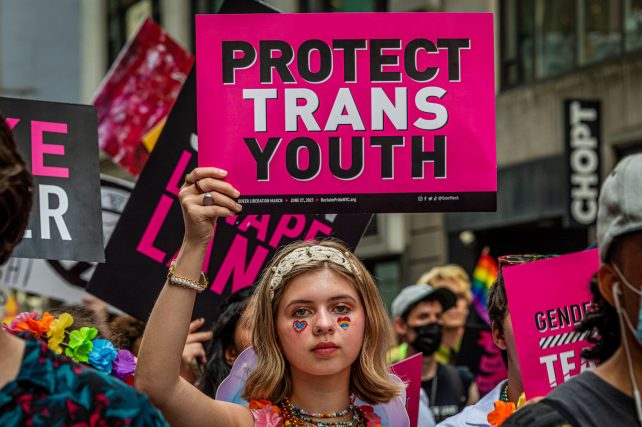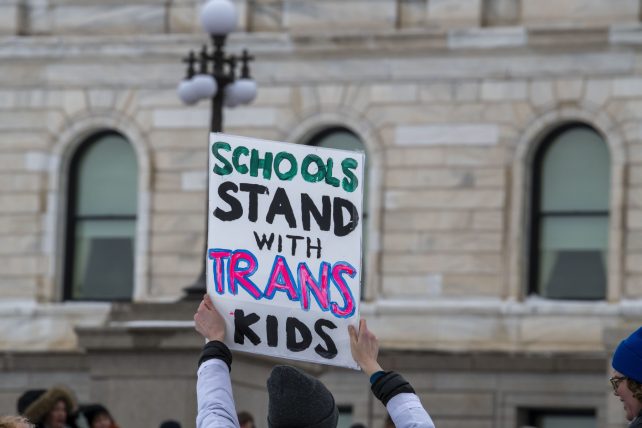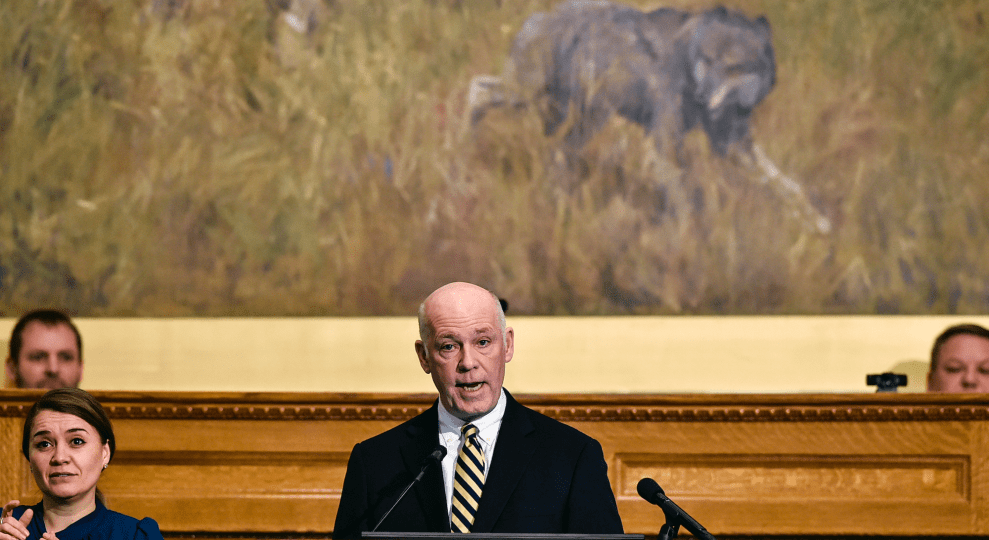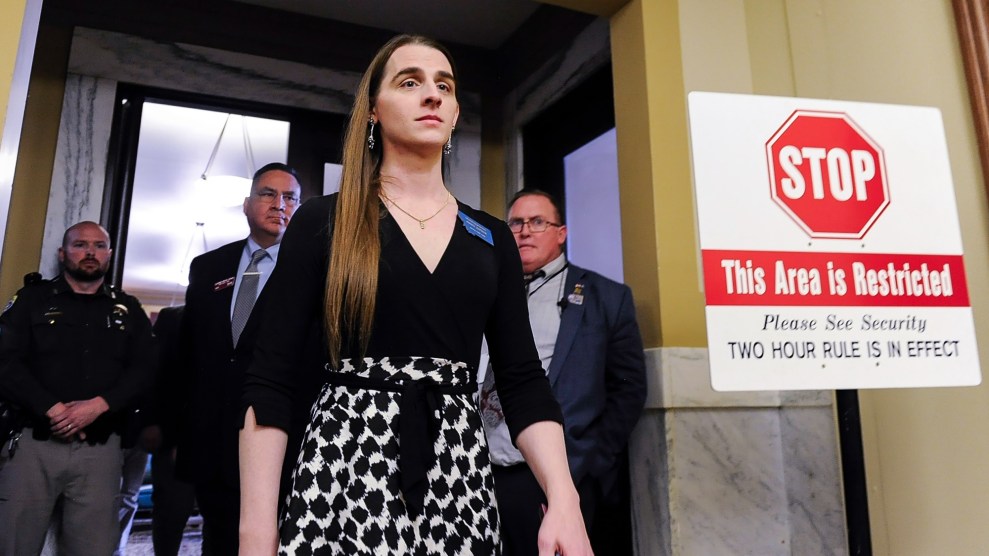
Janeen Jones, Center for Public Integrity; Getty
This story is published in partnership with the Center for Public Integrity, a nonprofit investigative reporting newsroom.
Hundreds of anti-transgender bills proposed in state legislatures are sold as measures to protect minors—such as Idaho’s Vulnerable Child Protection Act and Montana’s Youth Health Protection Act—but advocacy groups and doctors warn that the effect is exactly the opposite. So far this year, legislators in nearly every state have introduced over 550 anti-transgender bills—more than in the past eight years combined. Nearly 30 such bills have been introduced in Congress.
The onslaught includes limits on healthcare access, removing LGBTQ+ materials from schools, and banning trans athletes from sports teams. Seventy-two measures are now law. “Young people are being harmed, regardless of whether bills pass or not,” said Casey Pick, director of law and policy at the Trevor Project, a nonprofit that provides crisis support to LGBTQ+ youth.
In a nationwide survey of LGBTQ+ teens and young adults in late 2022, the Trevor Project found that 86% of transgender and nonbinary youth said anti-trans bills negatively impacted their mental health. “It’s a constant debate on my existence and it just makes me exhausted and frustrated that I have to legitimately just live,” one trans individual responded.
Others said they feared for their life, safety, and future.
The survey found other impacts from the legislation, including:
-
- 45% of transgender respondents experienced online harassment
- 24% were bullied at school
- 42% stopped speaking to a family member
“LGBTQ young people are watching, and internalizing the anti-LGBTQ messages they see in the media and from their elected officials,” Kasey Suffredini, vice president of advocacy and government affairs at the Trevor Project, said in a statement. “And so are those that would do our community harm.”

A participant holds a sign at the Reclaim Pride Coalition’s third annual Queer Liberation March in Manhattan in June 2021.
Erik McGregor/LightRocket/Getty
In 20 states, those younger than 18 have lost or will soon lose access to the health care necessary to transition to the gender with which they identify. Legislatures in seven other states are considering similar policies, according to the Human Rights Campaign.
Gender-affirming care encompasses a range of social, medical, behavioral, and psychological services to support and affirm a person’s gender identity when in conflict with the one they were assigned at birth. Treatment plans vary depending on the needs of the individual. It can include puberty blockers, which pause development to give an individual time to decide whether to continue transitioning. They are completely reversible. Puberty blockers also have been used for decades on cisgender children experiencing early-onset puberty. In later adolescence, a transgender teenager might undergo hormone therapy. The medication can help align a person’s body with their gender identity, including regulating hair growth and vocal pitch. It is partially reversible.
Despite rhetoric used by prominent Republican politicians like Florida Gov. Ron DeSantis and U.S. Rep. Marjorie Taylor Greene, gender-affirming surgeries are uncommon in patients under 18. Current medical guidelines say minors should not undergo genital surgery. Chest surgery is recommended only in specific cases—and after a teen has lived as their desired gender for ample time and undergone hormone therapy for at least a year.
More than a dozen studies of trans youth show that access to gender-affirming care is associated with better mental health outcomes. It has also been recognized as a medical necessity by more than 25 major medical organizations. But new policies in some states eliminate options for those wishing to transition.
“When you have legislation that works to require people to hide or not be in their own identities, it will likely cause substantial damage to their health and wellness,” said Christopher AhnAllen, a clinical psychologist who developed the Gender Diversity Clinic at Brigham and Women’s Hospital in Massachusetts. AhnAllen said some of his own patients have expressed concerns about the recent anti-trans legislation and debates.
While most legislation applies only to new patients, proposals in some states—including South Dakota, Tennessee, Texas, and Kentucky—require youth currently receiving care to stop, effectively forcing them to de-transition.“Detransitioning is going to exacerbate gender dysphoria and collectively lead to poor health outcomes,” AhnAllen said.

A protestor holds a sign during a rally at the capitol in St. Paul to support trans kids in Minnesota, Texas and around the country.
Michael Siluk/UCG/Universal Images Group/Getty
In 2020, the Idaho legislature passed the country’s first statewide law banning transgender student-athletes from playing on sports teams that match their gender identity. Florida’s 2022 “Don’t Say Gay” law was the first enacted in the country in 20 years, restricting school employees from discussing gender identity and sexual orientation. Similar proposals in over a dozen states followed. The American Civil Liberties Union tallied over 200 anti-LGBTQ+ bills relating to schools and education proposed by state legislators this year.
“Following a year of unprecedented book bans and classroom gag orders, this state legislation is not surprising,” said LGBTQ+ youth activist Cameron Samuels. Now a freshman at Brandeis University, they led a successful effort, along with the ACLU, to reverse book bans and internet censorship at their high school in Katy, Texas.

Cameron Samuels
Cindy Ord/Getty
For years, the Katy Independent School District had blocked online resources like the Trevor Project, the Human Rights Campaign and other LGBTQ+ advocacy groups with a “human sexuality” filter, according to the Houston Chronicle. The school also removed “books upon books” touching on topics like LGBTQ+ identities and race, Samuels said. Classroom censorship bills proposed across the country aim to do the same—but at a statewide level. “These policies are not just political statements but affect our very lives each and every day,” Samuels said. “It could be a matter of life and death whether a student can access a suicide prevention lifeline like the Trevor Project.”
LGBTQ+ students’ need for these resources could rise as advocacy groups track an increase in hostile educational environments. A 2021 study by the Gay, Lesbian, and Straight Education Network also found negative impacts on trans youth as a result of anti-trans legislation. Its recent research on school climates suggests the nationwide debates over trans rights have created more hostile attitudes toward LGBTQ+ students.
“Trans and nonbinary young people in schools who have been targeted by these athletic bans and medical bans have reported higher rates of things like bullying and harassment,” said Aaron Ridings, GLSEN chief of staff and deputy executive director for public policy and research.
Ridings said GLSEN research shows that four supports are critical for LGBTQ+ students. These include curriculum that represents all students, youth leadership clubs like Gay-Straight Alliances, comprehensive anti-discrimination policies, and a network of supportive adults. “These four supports improve school climate, student health, and academic achievement,” Ridings said.
But those supports would be restricted under numerous bills proposed in state legislatures. Some have already passed this year. Arkansas, Idaho, Iowa, and Kentucky enacted so-called “bathroom bans,” which prohibit trans students from using restrooms that align with their gender identities. Wyoming and Kentucky banned trans girls from participating in interscholastic girls’ sports.
New laws in Utah and Arkansas prevent schools from acknowledging trans students’ gender identities, including preferred name, and pronouns, without written parental permission. An Indiana bill would require school staff—including school psychologists—to notify a parent if their student requests to use a different name or pronoun. In late March, the Kentucky General Assembly overrode Gov. Andy Beshear’s veto of an omnibus anti-trans bill, which included prohibiting schools from requiring the use of preferred pronouns. The policy also bans lessons “studying or exploring gender identity, gender expression, or sexual orientation.”
Samuels, who is studying politics, said the students being affected by these anti-LGBTQ+ policies do not have an equal voice on school boards and in state legislatures. This has led to policy decisions being made “at the expense of students.”
“If we are proposing legislation that will harm a certain group of people, no matter how large or how small, it’s an attack on all of us, because this could happen to any community,” Samuels said.







